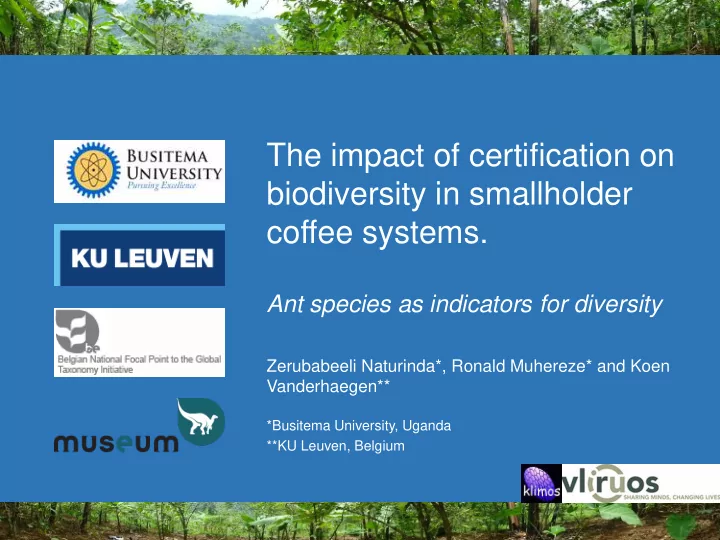

The impact of certification on biodiversity in smallholder coffee systems. Ant species as indicators for diversity Zerubabeeli Naturinda*, Ronald Muhereze* and Koen Vanderhaegen** *Busitema University, Uganda **KU Leuven, Belgium
Outline • Introduction • Hypotheses • Materials and Methodology • Results and Discussion • Ongoing research • Future research and projects
Research Area S.Sudan Uganda DRC Kenya
Coffea arabica L.
Coffea arabica L • Perennial crop + often in agroforestry systems • Ecosystem services o Soil enrichment o Improved air and water quality o Carbon sequestration and storage o Biodiversity conservation
Certification • Socio-Economic study: • PhD Kevin Teopista Akoyi • Biophysical study: • PhD chapter Koen Vanderhaegen Gumutindo Ltd Kyagalanyi Ltd “NON - ORGANIC certified” “ORGANIC certified”
Hypothesis 1. Certified coffee fields have a higher carbon stock than non-certified coffee fields. 2. Certified coffee fields conserve a higher biodiversity than non-certified coffee fields.
Hypothesis 1. Certified coffee fields have a higher carbon stock than non-certified coffee fields.
Hypothesis 2. Certified coffee fields conserve a higher biodiversity than non-certified coffee fields. o Organic certified coffee fields conserve a higher ant biodiversity than non-organic certified fields. o Tree species composition in coffee gardens is driven by certification.
Materials and Methodology • Sampling design: • Treatment group • Control group Stratified random sampling Matching o Group of farmers o Elevation o Soil type o Rainfall o Elevation o Distance main road o Distance MENP o Age household head o Ethnic group o Religion o Education household head
Materials and Methodology • Entomofauna inventory (ALL protocol)
Materials and Methodology • Sample processing Sorting Mounting Labelling
Materials and Methodology • Sample processing Species Identification Digitizing
Results and Discussion • 74 coffee gardens inventoried • 37 Certified, 37 Control • 18 Gumutindo, 19 Kyagalanyo • 52,616 insects sorted out • 36,716 ants grouped in morphospecies
Results and Discussion • Species richness based on individual sample data
Results and Discussion • Based on Baits: in general, reduced species richness under certification Method Certified Control Prob > |z| Baits 2.59(±1.77) 3.41(±1.62) 0.045 ** Litter 3.95(±2.66) 3.49(±2.02) 0.332 Winkler 1.97(±2.39) 2.24(±1.82) 0.254 Pitfall 8.3(±3.96) 8.57(±3.8) 0.681 Average (±SD) amount of morphospecies counted in samples collected using 4 methods in certified and matched control coffee gardens and the probability that these averages are significantly different based on Wilcoxon matched-pairs signed-ranks test (Prob > |z|). • But! Opposite trends expected.
Results and Discussion • Baits (S obs)
Results and Discussion • Baits (S obs) Gumutindo Kyagalanyi Certified Control Certified Control S obs 3 (±1.85) 3.67 (±1.37) 2.21 (±1.65) * 3.16 (±1.83) * p50 2.5 3.5 2 3 • Only for coffee gardens contracted with Kyagalanyi a significantly lower amount of morphospecies is observed in the bait samples (Prob > |z| = 0.0640)
Results and Discussion • Baits (Diversity, Evenness) Gumutindo Kyagalanyi Index Certified Control Certified Control H' 0.39 (±0.38) * 0.67 (±0.43) * 0.27 (±0.32) ** 0.52 (±0.46) ** p50 0.23 0.78 0.15 0.57 0.3 (±0.27) ** 0.54 (±0.33) ** E p 0.24 (±0.28) 0.38 (±0.31) p50 0.21 0.64 0.18 0.43 • Both groups of certified fields have a significantly lower Shannon Wiener species diversity . • Gumutindo certified fields have a significantly lower (Prob > |z| = 0.0429) species evenness (E p ) compared to their matched controls.
Results and Discussion • Winkler and Pitfall Samples No one of the used diversity measures (S obs, S est, Total abundance, D, H, S) indicates significant differences .
Results and Discussion • Also, certification is not a clear cut case…
Results and Discussion
Ongoing research • Once species are identified => repeat tests for combined data all sampling methods • Identify species communities • Link communities with environmental factors • Identify indicator species
Future research and projects • Upscaling of ant diversity research to other LU systems (2015, 136 plots inventoried). Ants as a biotic index? • Ant course Uganda, 2016? (contacts made with NAFORRI, Busitema U., UWA, …). • Donation of ant collection to NAFORRI. • Digitizing of all observed species => Ant Web
Thanks to: • GTI • Wouter Dekonick + RBINS • VLIR-UOS • Busitema University • KU Leuven • KLIMOS • All students and volunteers who participated
Recommend
More recommend